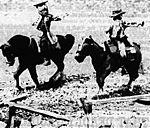In the game the player could have a command figure attempt to spur their troops on
with acts of bravery (or stupidity) in the face of the enemy. The rules
provided some historical color, fun and personality to BATTLE AND LEADERS.
The rules given here do the same.
ED NOTE: Yacqutnto is still in business as Yaquinto Printing, but not in publishing games. Steve Peek, Yaquinto's principal is however, still involved inputting out some 12-15 boardgames
a year. Steve who was author of Battles and Leaders kindly gave us permission to use these charts. Steve is presently President of The Association of Game Inventors of America and a member of the GAMA Board of Directors.
The grand gesture was the effort of leaders to inspire friendly troops by employing behavior that put them at risk. It always involved placing himself in front of his men, becoming a target. Officers in the Civil War, in attempts to encourage temperamental citizen soldiers, made grand gestures often. One result was the high casualty rate among officers, Blue and Gray.
Another was the surprising enthusiasm demonstrated at times by the rank and file.
I have taken the liberty of incorporating the BATTLES AND LEADERS Grand
Gesture table into my optional rules because it is very well done.
The following Grand Gesture options can be used with any set of rules. I will give the specifics for applying it to JOHNNY REB, ON TO RICHMOND, and FIRE AND FURY. During a player's turn, officer figures, Brigade, Divisional, or Corps, may make Grand Gestures in an effort to increase the influence they have over their troops or the morale of the unit. The unit to be "impressed" must be within artillery and/or small arms range and have been fired upon in the previous turn. The officer figure can move to the unit before performing the gesture.
The Grand Gesture is carried out before the unit moves or fires. If the officer survives the Grand Gesture, the figure must stay with the unit for the remainder of the turn, even leading it in any combat it participates in. The figure making the Grand Gesture is always placed in front of the unit, facing the enemy. An officer can only make one Grand Gesture a turn for the smallest infantry or cavalry unit size in the game: Regiments for JOHNNY REB & Brigades for OTR and FIRE AND FURY.
The Grand Gesture is diced for IN ADDITION to any officer fire or melee
casualty normally rolled for in the turn. As an example, a Division Commander
in OTR who survived a Grand Gesture while in front of a brigade which later
in the turn suffers rifle fire, must roll to determine if he is a casualty. Announcing the Grand Gesture
When the Grand Gesture is announced, the unit to be influenced is identified
and the officer is moved to the front of the unit. Two D10 are rolled, and read as "00" through "99".
The results are found and read on the table, the descriptions for fun, the information in parenthesis being applied immediately. The results are in effect for the rest of the game, unless changed by further Grand Gestures.
This article appears in MagWeb (Magazine Web) on the Internet World Wide Web. One of the most entertaining Civil War board games to be published was Yacquinto's BATTLES AND LEADERS (Copyright 1981, Yaquinto Publishing
Inc.). Unforturnately, the company is no longer publishing the game, but I still use one of the game's concepts: The Grand Gesture.
One of the most entertaining Civil War board games to be published was Yacquinto's BATTLES AND LEADERS (Copyright 1981, Yaquinto Publishing
Inc.). Unforturnately, the company is no longer publishing the game, but I still use one of the game's concepts: The Grand Gesture.
THE GRAND GESTURE
Back to Table of Contents -- Courier #65
© Copyright 1994 by The Courier Publishing Company.
Other military history articles and gaming articles are available at http://www.magweb.com